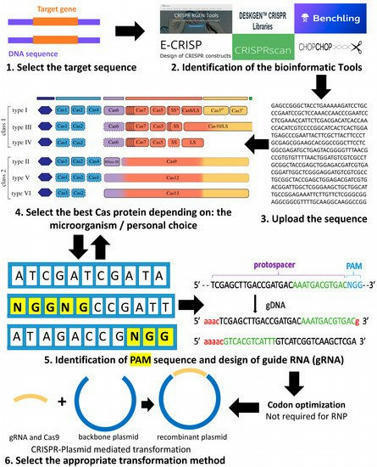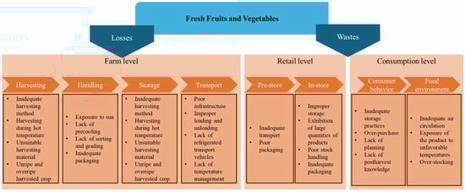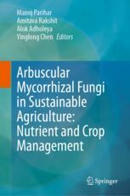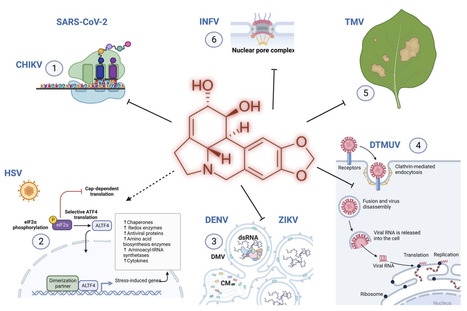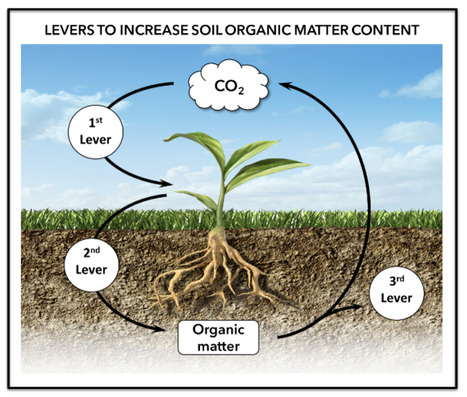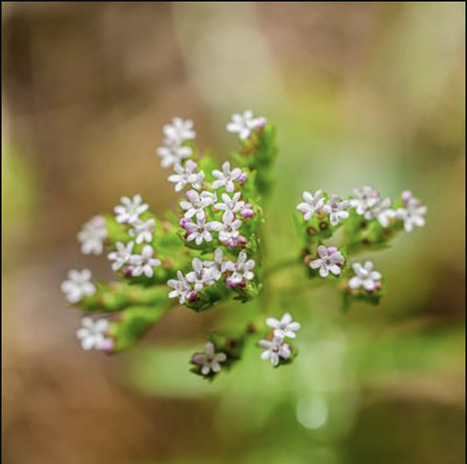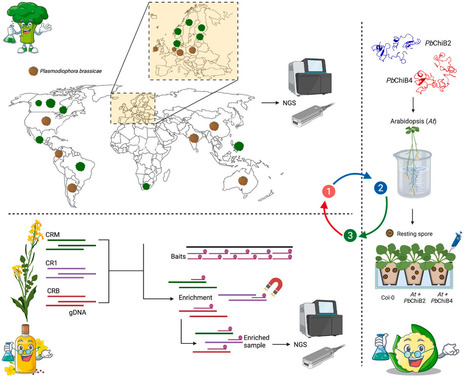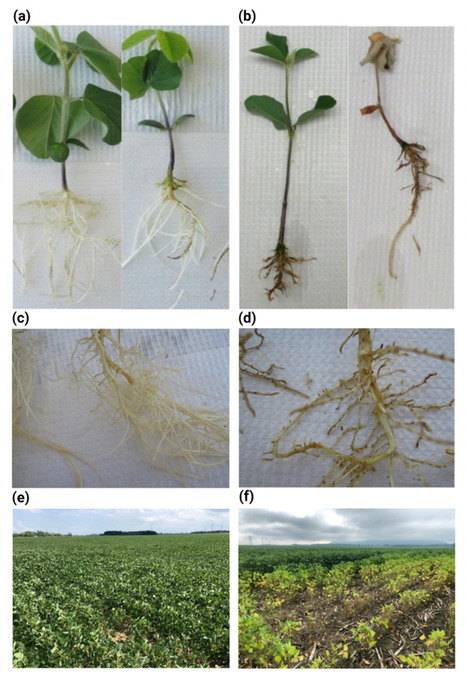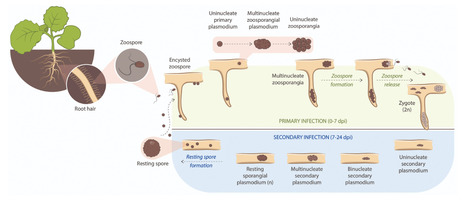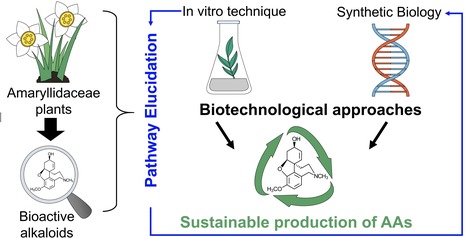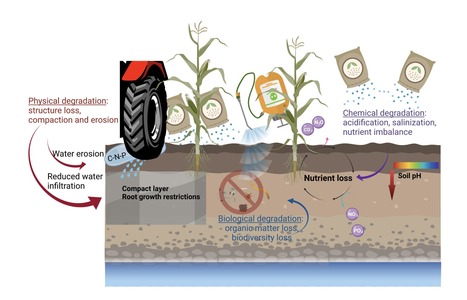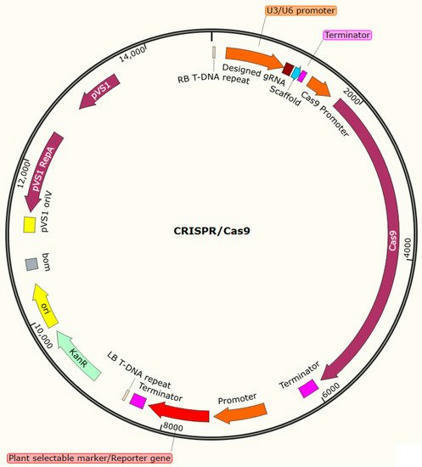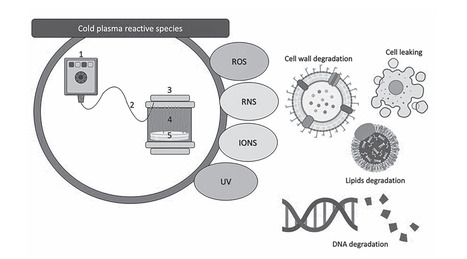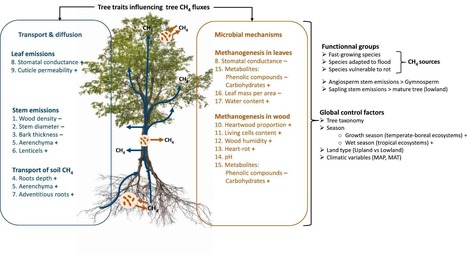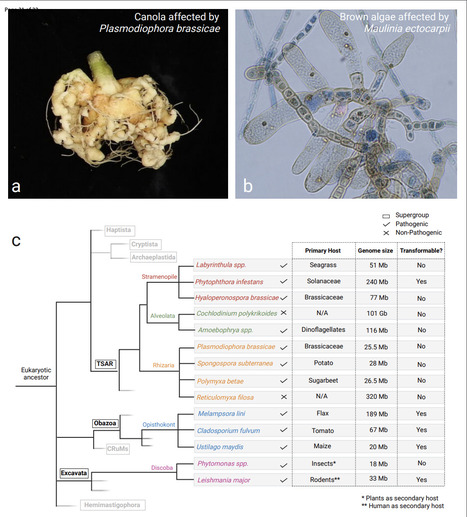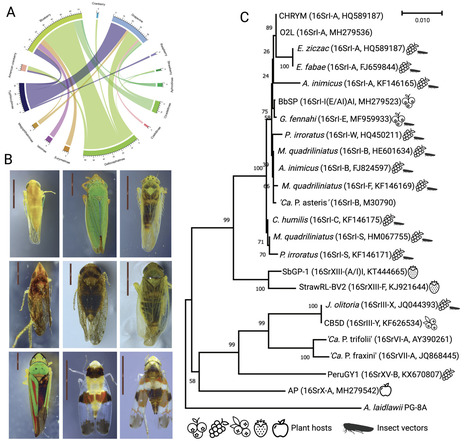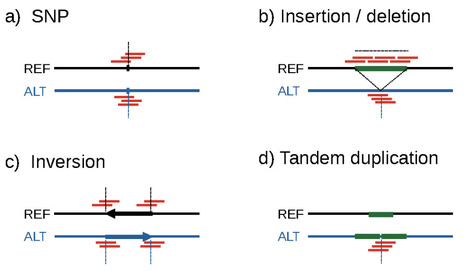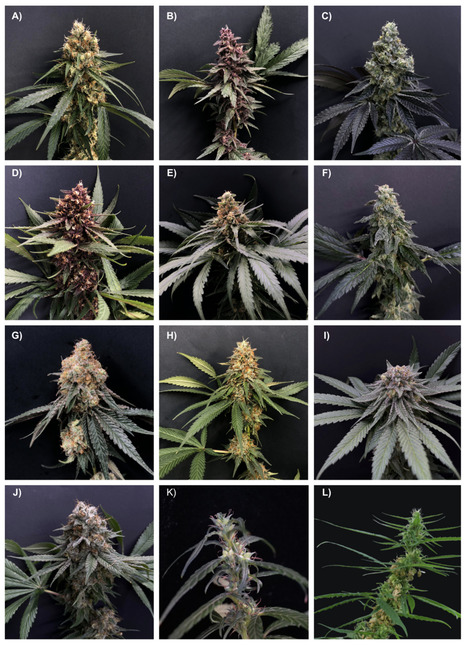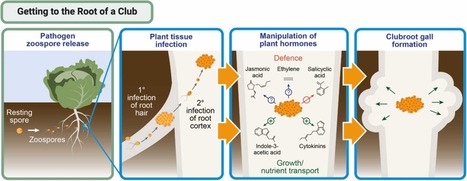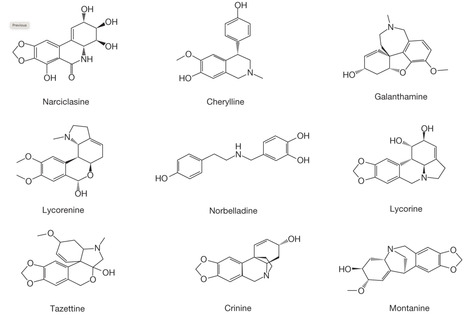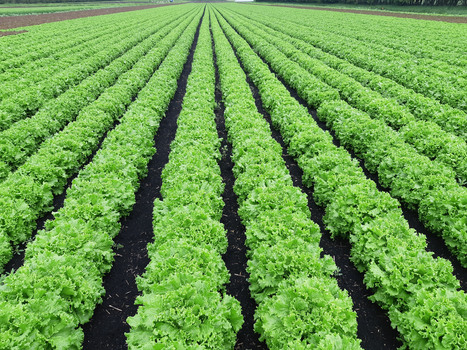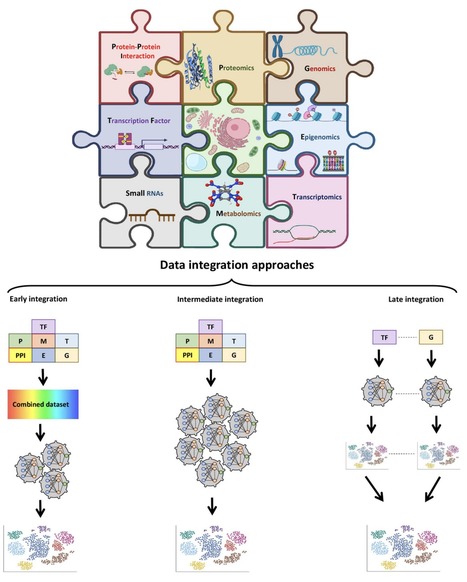 Your new post is loading...
 Your new post is loading...

|
Scooped by
ulcriv
November 11, 2024 2:16 PM
|
Food loss and waste occur throughout the food supply chain and represent food security and environmental, economic, and societal problems. Fresh fruit and vegetables contribute to over 40% of global food loss and waste. A significant portion of fruit and vegetables loss takes place on the farm during postharvest handling in developing countries, which is linked to smallholders’ financial and geographic constraints in purchasing modern postharvest handling technologies. While in developed countries, waste is the main problem identified at the retail and consumption levels because of inadequate logistics management, storage, and consumer behavior. The loss and waste deprive the population of a significant quantity of healthy food. To address this challenge, cost-effective, easy-to-use, and affordable approaches could be supplied to stakeholders. These strategies encompass the utilization of shading, low-cost packaging, porous evaporative cooling, zero-energy cooling chambers, and pot-in-pot coolers, for reductions in loss in developing countries. Meanwhile, in developed countries, biosensors, 1-methylcyclopropene, and imaging processing are employed to assess the quality of fresh fruit and vegetables at both retail and consumer levels. By exploring these methods, the review aims to provide smallholders, retailers, and consumers with efficient methods for improving produce operating techniques, resulting in reduced losses and waste and higher income.

|
Scooped by
ulcriv
November 9, 2024 8:23 AM
|
Managing abiotic stresses in agroecosystems is a critical challenge in modern agriculture. Climate change exacerbates these conditions, making it difficult to cultivate crops in productive areas. Arbuscular mycorrhizal fungi (AMF) have emerged as a promising solution to this problem. The symbiotic relationship between AMF and plants can increase nutrient efficiency, reduce water use, and promote soil health. However, certain questions require further exploration, such as: (a) How does AMF enhance plant resilience against abiotic stresses? (b) How can we favorize the occurrence of AMF in soils and boost the colonization of plant roots in agroecosystems? This chapter explores the role of AMF in the management of abiotic stress in agroecosystems. This review examines the edaphoclimatic factors contributing to abiotic stress, and reviews how AMF can improve plant growth and stress tolerance. With a better understanding of these mechanisms, AMF can be applied to improve plant growth and stress tolerance in agroecosystems. It is also necessary to develop more efficient and cost-effective methods for AMF inoculation. AMF can help farmers overcome the challenges of modern agriculture and achieve sustainable crop production in the face of climate change. This chapter also outlines the current challenges and limitations of AMF technology, as well as future perspectives and directions for research.

|
Scooped by
ulcriv
May 3, 2024 5:04 PM
|
Amaryllidaceae alkaloid (AAs) biosynthesis has garnered significant attention in recent years, particularly with the commercialisation of galanthamine as a treatment for the symptoms of Alzheimer‟s disease. A significant amount of research work over the last 8 decades has focused on the understanding of AA biosynthesis, starting from early radiolabelling studies to recent multi-omics analysis with modern biotechnological advancements. Those studies enabled the identification of hundreds of metabolites, the characterisation of biochemical pathway, an understanding of the environmental stimuli, and of the molecular regulation of these pharmaceutically and agriculturally important metabolites. Despite the numerous works there remain significant gaps in understanding their biosynthesis in Amaryllidaceae plants. As such, further research is needed to fully elucidate the metabolic pathway and facilitate their production. This review aims to provide a comprehensive overall summary of the current state of knowledge on AAs biosynthesis, from elicitation of transcription factors expression in the cell nucleus to alkaloid transport in the apoplast, and to highlight the challenges that need to be overcome for further advancement.

|
Scooped by
ulcriv
January 26, 2024 8:46 AM
|
Amaryllidaceae alkaloids (AAs) are a unique class of specialized metabolites containing heterocyclic nitrogen bridging that play a distinct role in higher plants. Irrespective of their diverse structures, most AAs are biosynthesized via intramolecular oxidative coupling. The complex organization of biosynthetic pathways is constantly enlightened by new insights owing to the advancement of natural product chemistry, synthetic organic chemistry, biochemistry, systems and synthetic biology tools and applications. These promote novel compound identification, trace-level metabolite quantification, synthesis, and characterization of enzymes engaged in AA catalysis, enabling the recognition of biosynthetic pathways. A complete understanding of the pathway benefits biotechnological applications in the long run. This review emphasizes the structural diversity of the AA specialized metabolites involved in biogenesis although the process is not entirely defined yet. Moreover, this work underscores the pivotal role of synthetic and enantioselective studies in justifying biosynthetic conclusions. Their prospective candidacy as lead constituents for antiviral drug discovery has also been established. However, a complete understanding of the pathway requires further interdisciplinary efforts in which antiviral studies address the structure–activity relationship. This review presents current knowledge on the topic.

|
Scooped by
ulcriv
July 21, 2023 10:55 AM
|
One widely recognized climate change mitigation strategy in agriculture is enhancing soil carbon (C) sequestration – the process of capturing atmospheric carbon dioxide and storing it in the soil. By adopting natural climate solutions (NCS) such as cover crops, reduced tillage, and diverse crop rotations, farmers can increase soil C sequestration and co-benefits such as biodiversity. Canada is increasingly interested in better positioning farmers to adopt NCS via government cost-share programs, ecosystem marketplaces, and outreach and education initiatives. Given the policy and market driven interest in soil C sequestration in agriculture, there is a need to advance the science policy interface, ensuring foundational science, NCS implementation, and approaches to promote NCS are aligned. Herein, the objective is to present insights from multiple disciplines that can help build connections between soil carbon sequestration science and policy relevant to Canada's croplands. The method is a review of literature on soil and pedoclimate science, agricultural NCS adoption, agricultural NCS governance, and science policy interfaces to achieve this objective. From this review, key insights underline that Canadian cropland soils do not have a homogenous history in NCS adoption and production type, nor are all regions influenced by the same contextual factors, have the same potential in C storage or exist within the same agri-environmental conditions. Therefore, it is emphasized herein that policies that aim to enhance soil organic carbon in croplands should consider local context and C sequestration potential. Policies and programs implemented locally to enhance C sequestration across Canada should be complemented by nationally scalable measuring and monitoring to ensure outcomes are accounted for against climate goals. This review aims to contribute to building a common understanding of soil C sequestration in Canada’s croplands and its science policy interface. Efforts to further strengthen the science policy interface for soil C sequestration in Canada’s croplands might include greater integration and utilization of science and data from multiple disciplines, co-design and collaborative opportunities, and establishing on-the-ground test projects to explore innovation in policy and market design.

|
Scooped by
ulcriv
July 21, 2023 9:59 AM
|
As green chemical factories, medicinal plants contain a wide range of bioactive compounds crucial for biomaterial industries. Despite their high economic value, medicinal plants are in the last ring of domestication syndrome and have been neglected for many years by plant breeders. In recent years, plant scientists have tried to compensate for these shortages by developing different strategies, especially faster biotechnology-based methods (BBMs) to conserve and improve these valuable but neglected plants. For the first step, the information and awareness of endangered medicinal plants is very important. Kakkar et al. reviewed all available information related to the nomenclature and classification, endangerment, plant morphology, ploidy, secondary metabolites, drug pharmacokinetics, conservation, and omics-based computational studies in Aconitum genus. The presented information is very valuable in terms of conservation of endangered economically important poisonous mountainous medicinal plant species in this genus.The assessment of the genetic background of valuable medicinal plants is the second step to improve medicinal plants and schedule efficient breeding programs. In this context, the research article by Wei et al. applied the complete chloroplast genome sequencing and phylogenetic study to distinguish three Gaoben-related medicinal plants, including Ligusticum sinense, L. jeholense, and Conioselinum vaginatum, which are similar in morphology and are difficult t

|
Scooped by
ulcriv
February 20, 2023 2:20 PM
|
Clubroot is a devastating disease affecting cruciferous crops worldwide, caused by the obligate parasite Plasmodiophora brassicae. Currently, the use of clubroot resistant cultivars is the best strategy to stop the spreading of the disease and avoid millionaire loses experienced by the industry every year. Unfortunately, after decades of research, clubroot resistance is being overcome by new pathotypes and the mechanisms behind this remain unknown. Here we discuss how we can advance our understanding of the pathogen and the host through genomics. However, this multilayered strategy needs to be concerted to find a stable solution for growers.

|
Scooped by
ulcriv
January 5, 2023 8:32 AM
|
Phytophthora sojae, the agent responsible for stem and root rot, is one of the most damaging plant pathogens of soybean. To establish a compatible-interaction, P. sojae secretes a wide array of effector proteins into the host cell. These effectors have been shown to act either in the apoplastic area or the cytoplasm of the cell to manipulate the host cellular processes in favor of the development of the pathogen. Deciphering effector-plant interactions is important for understanding the role of P. sojae effectors in disease progression and developing approaches to prevent infection. Here, we review the subcellular localization, the host proteins, and the processes associated with P. sojae effectors. We also discuss the emerging topic of effectors in the context of effector-resistance genes interaction, as well as model systems and recent developments in resources and techniques that may provide a better understanding of the soybean-P. sojae interaction.

|
Scooped by
ulcriv
November 30, 2022 8:51 AM
|
Background: Plasmodiophora brassicae is the causal agent of clubroot disease of cru-ciferous plants and one of the biggest threats to the rapeseed (Brassica napus) and brassica vegetable industry worldwide. Disease symptoms: In the advanced stages of clubroot disease wilting, stunting, yel-lowing, and redness are visible in the shoots. However, the typical symptoms of the disease are the presence of club-shaped galls in the roots of susceptible hosts that block the absorption of water and nutrients. Host range: Members of the family Brassicaceae are the primary host of the patho-gen, although some members of the family, such as Bunias orientalis, Coronopus squa-matus, and Raphanus sativus, have been identified as being consistently resistant to P. brassicae isolates with variable virulence profile. Taxonomy: Class: Phytomyxea; Order: Plasmodiophorales; Family: Plasmodiophoraceae; Genus: Plasmodiophora; Species: Plasmodiophora brassicae (Woronin, 1877). Distribution: Clubroot disease is spread worldwide, with reports from all continents except Antarctica. To date, clubroot disease has been reported in more than 80 countries. Pathotyping: Based on its virulence on different hosts, P. brassicae is classified into pathotypes or races. Five main pathotyping systems have been developed to under-stand the relationship between P. brassicae and its hosts. Nowadays, the Canadian clubroot differential is extensively used in Canada and has so far identified 36 differ-ent pathotypes based on the response of a set of 13 hosts. Effectors and resistance: After the identification and characterization of the clubroot pathogen SABATH-type methyltransferase PbBSMT, several other effectors have been characterized. However, no avirulence gene is known, hindering the functional characterization of the five intercellular nucleotide- binding (NB) site leucine- rich- repeat (LRR) receptors (NLRs) clubroot resistance genes validated to date.

|
Scooped by
ulcriv
October 21, 2022 2:33 PM
|
Amaryllidaceae alkaloids (AAs) are plant specialized metabolites with therapeutic properties exclusively produced by the Amaryllidaceae plant family. The two most studied representatives of the family are galanthamine, an acetylcholinesterase inhibitor used as a treatment of Alzheimer’s disease, and lycorine, displaying potent in vitro and in vivo cytotoxic and antiviral properties. Unfortunately, the variable level of AAs’ production in planta restricts most of the pharmaceutical applications. Several biotechnological alternatives, such as in vitro culture or synthetic biology, are being developed to enhance the production and fulfil the increasing demand for these AAs plant-derived drugs. In this review, current biotechnological approaches to produce different types of bioactive AAs are discussed.

|
Scooped by
ulcriv
October 21, 2022 2:31 PM
|
Phytotechnology has traditionally been considered as a tool to remediate contaminated soils. While phytotechnology has been generally defined as the application of science and engineering to study problems and provide solutions involving plants, the practical applications go far beyond restoring contaminated land. This review aims to broaden the way we think about phytotechnologies while highlighting how these living technologies can restore, conserve and regenerate the multiple functions and ecosystem services provided by the soil, particularly in the context of agroecosystems. At first, the main problems of soil degradation in agroecosystems are shortly underlined. Subsequently, the importance of plants and their living roots as engines of restoration are reviewed. This paper demonstrates the importance of root traits and functions for soil restoration. It also demonstrates that plant and root diversity together with perenniality are key component of an efficient soil restoration process. Then, a phytotechnology toolbox which includes three pillars for agroecosystems restoration is presented. The three pillars are agricultural practices and land management (1), rhizosphere engineering (2) and ecological intensification (3). This paper also highlights the importance of developing targeted phytotechnology-based restoration strategies developed from root functions and knowledge of rhizosphere processes. More work is needed to evaluate the potential benefits of incorporating phytotechnology-based restoration strategies in the context of grain or vegetable crop productions as most of the studies for agroecosystem restoration strategies were intended to mimic natural prairies.

|
Scooped by
ulcriv
April 12, 2022 3:28 PM
|
Sequence and expression data obtained by next-generation sequencing (NGS)-based forward genetics methods often allow the identification of candidate causal genes. To provide true experimental evidence of a gene’s function, reverse genetics techniques are highly valuable. Site-directed mutagenesis through transfer DNA (T-DNA) delivery is an efficient reverse screen method in plant functional analysis. Precise modification of targeted crop genome sequences is possible through the stable and/or transient delivery of clustered regularly interspaced short palindromic repeat (CRISPR)/CRISPR-associated protein (CRISPR/Cas) reagents. Currently, CRISPR/Cas9 is the most powerful reverse genetics approach for fast and precise functional analysis of candidate genes/mutations of interest. Rapid and large-scale analyses of CRISPR/Cas-induced mutagenesis is achievable through Agrobacterium rhizogenes-mediated hairy root transformation. The combination of A. rhizogenes hairy root-CRISPR/Cas provides an extraordinary platform for rapid, precise, easy, and cost-effective “in root” functional analysis of genes of interest in legume plants, including soybean. Both hairy root transformation and CRISPR/Cas9 techniques have their own complexities and considerations. Here, we discuss recent advancements in soybean hairy root transformation and CRISPR/Cas9 techniques. We highlight the critical factors required to enhance mutation induction and hairy root transformation, including the new generation of reporter genes, methods of Agrobacterium infection, accurate gRNA design strategies, Cas9 variants, gene regulatory elements of gRNAs and Cas9 nuclease cassettes and their configuration in the final binary vector to study genes involved in root-related traits in soybean.

|
Scooped by
ulcriv
October 21, 2022 1:33 PM
|
Plants are sessile in nature and they perceive and react to environmental stresses such as abiotic and biotic factors. These induce a change in the cellular homeostasis of reactive oxygen species (ROS). ROS are known to react with cellular components, including DNA, lipids, and proteins, and to interfere with hormone signaling via several post-translational modifications (PTMs). Protein carbonylation (PC) is a non-enzymatic and irreversible PTM induced by ROS. The non-enzymatic feature of the carbonylation reaction has slowed the efforts to identify functions regulated by PC in plants. Yet, in prokaryotic and animal cells, studies have shown the relevance of protein carbonylation as a signal transduction mechanism in physiological processes including hydrogen peroxide sensing, cell proliferation and survival, ferroptosis, and antioxidant response. In this review, we provide a detailed update on the most recent findings pertaining to the role of PC and its implications in various physiological processes in plants. By leveraging the progress made in bacteria and animals, we highlight the main challenges in studying the impacts of carbonylation on protein functions in vivo and the knowledge gap in plants. Inspired by the success stories in animal sciences, we then suggest a few approaches that could be undertaken to overcome these challenges in plant research. Overall, this review describes the state of protein carbonylation research in plants and proposes new research avenues on the link between protein carbonylation and plant redox biology.
|

|
Scooped by
ulcriv
November 11, 2024 1:30 PM
|
The utilization of alternate treatments to enhance the quality and safety of fresh produce has become a challenge for food industries and scientists. Cold plasma (CP) is an emerging technology that involves the generation of reactive gases, which through the generation of reactive species interact with microbial loads and lead chemical reactions to induce bioactive components. Despite the many applications of this technology, the mechanisms of action still need to be fully understood. The definition of CP involves several types of treatments and sources, providing the potential to develop adaptations within the parameters to reach optimal results. The scalability of these treatments to laboratory conditions, however, requires a deeper understanding. The use of CP to reduce pathogen loads such as Listeria monocytogenes, E. coli O157:H7 and Salmonella has been described; besides, the enhancement of bioactive constituents such as anthocyanins, phenols and carotenoids is also probed. Furthermore, the mechanisms of action of CP treatments are described. At the moment, CP treatments require further development and study to achieve their full range of industrial applications. These treatments can also be key for postharvest handling and research, mainly to preserve quality and prolong the shelf life of produce.

|
Scooped by
ulcriv
November 8, 2024 10:54 AM
|
Trees can play different roles in the regulation of fluxes of methane (CH4), a greenhouse gas with a warming potential 83 times greater than that of carbon dioxide. Forest soils have the greatest potential for methane uptake compared to other land uses. In addition to their influence on soil CH4 fluxes, trees can act directly as a source or sink of CH4, by transporting CH4 produced in the soil and harbouring the key microorganisms involved in CH4 production and consumption (methanogens and methanotrophs). Tree CH4 fluxes can vary between species characterized by different traits that influence transport and modify the availability of CH4 reaction substrates as well as the habitat for methanogens and methanotrophs. Despite their important role in modulating CH4 fluxes from forest ecosystems, the identity and role of tree traits influencing these fluxes are poorly consolidated in the literature. The objectives of this paper are to 1) Review the functional traits of trees associated with their role in the regulation of CH4 emissions; 2) Assess the importance of inter-specific variability in CH4 fluxes via a global analysis of tree methane fluxes in the literature. Our review highlights that differences in CH4 fluxes between tree species and individuals can be explained by a diversity of traits influencing CH4 transport and microbial production of CH4 such as wood density and secondary metabolites. We propose a functional classification for trees based on the key traits associated with a function in CH4 emissions. We identified the fast-growing species with low wood density, species adapted to flood and species vulnerable to rot as functional groups which can be net sources of CH4 in conditions favorable to CH4 production. The global analysis further demonstrated the importance of taxonomy, with other factors such as land type and season in explaining variability in tree CH4 fluxes.

|
Scooped by
ulcriv
May 3, 2024 4:22 PM
|
Interactions between various microbial pathogens including viruses, bacteria, fungi, oomycetes and their plant hosts have traditionally been the focus of phytopathology. In recent years, a significant and growing interest in the study of eukaryotic microorganisms not classified among fungi or oomycetes has emerged. Many of these protists establish complex interactions with photosynthetic hosts, and understanding these interactions is crucial in understanding the dynamics of these parasites within traditional and emerging types of farming, including marine aquaculture. Many phytopathogenic protists are biotrophs with complex polyphasic life cycles, which makes them difficult or impossible to culture, a fact reflected in a wide gap in the availability of comprehensive genomic data when compared to fungal and oomycete plant pathogens. Furthermore, our ability to use available genomic resources for these protists is limited by the broad taxonomic distance that these organisms span, that makes comparisons with other genomic datasets difficult. The current rapid progress in genomics and computational tools for the prediction of protein functions and interactions is revolutionising the landscape in plant pathology. This is also opening novel possibilities, specifically for a deeper understanding of protist effectors. Tools such as Alphafold enable better and more targeted functional predictions of divergent protein sequences. In turn this allows to ask better biological questions and, coupled with innovative experimental strategies, will lead into a new era of effector research, especially for protists, to expand our knowledge on these elusive pathogens and their interactions with photosynthetic hosts.

|
Scooped by
ulcriv
January 26, 2024 8:20 AM
|
Climate change has facilitated the introduction, establishment, and movement of invasive species in northern regions, enabling the colonization of previously unsuitable areas. While the responses of insects to these changes have been increasingly studied, our understanding of how such alterations impact trophic interactions still requires further research to make reliable predictions about the spread of diseases in a warming world. Phytoplasmas, a group of obligate parasitic unculturable Mollicutes, primarily rely on leafhoppers (Hemiptera: Cicadellidae) for transmission, spread, and survival. Phytoplasmas are associated with over 600 diseases affecting more than 1,000 plant species, including berries, grapevines, and other small fruits. In North America, diseases such as grapevine yellows, blueberry stunt, and strawberry green petal diseases have been linked to phytoplasma strains transmitted by known leafhopper species. However, the number of phytoplasma diseases has significantly increased in North America over the past decade, suggesting the presence of unidentified vectors or an abundance of leafhopper vectors. This short review provides an overview of the current knowledge on leafhoppers as vectors of phytoplasmas to berries, focusing on the last decade’s research in Canada. This paper also explores the potential implications of climate change on this pathosystem, including the anticipated range expansion of leafhopper species, changes in phytoplasma acquisition and transmission, and the risk of new leafhopper-transmitted plant-pathogen introductions through the arrival of new leafhopper species.

|
Scooped by
ulcriv
July 21, 2023 10:49 AM
|
Genome-wide association studies (GWAS) have allowed the discovery of marker–trait associations in crops over recent decades. However, their power is hampered by a number of limitations, with the key one among them being an overreliance on single-nucleotide polymorphisms (SNPs) as molecular markers. Indeed, SNPs represent only one type of genetic variation and are usually derived from alignment to a single genome assembly that may be poorly representative of the population under study. To overcome this, k-mer-based GWAS approaches have recently been developed. k-mer-based GWAS provide a universal way to assess variation due to SNPs, insertions/deletions, and structural variations without having to specifically detect and genotype these variants. In addition, k-mer-based analyses can be used in species that lack a reference genome. However, the use of k-mers for GWAS presents challenges such as data size and complexity, lack of standard tools, and potential detection of false associations. Nevertheless, efforts are being made to overcome these challenges and a general analysis workflow has started to emerge. We identify the priorities for k-mer-based GWAS in years to come, notably in the development of user-friendly programs for their analysis and approaches for linking significant k-mers to sequence variation.

|
Scooped by
ulcriv
July 21, 2023 8:29 AM
|
In the 18th century, Carolus Linnaeus created a formalized system of classification of living organisms based on their anatomic relationships, which we know as taxonomic nomenclature. Historically, the genus Cannabis has been described three ways under this system: Cannabis sativa by C. Linnaeus in 1753, Cannabis indica by J.B. Lamarck in 1785, and Cannabis ruderalis by D.E. Janischewsky in 1924, with these taxonomic classifications having been derived from physical, morphological, chemical, and geographical data. Today, this confusing taxonomy has led to an ongoing debate about whether the genus Cannabis consists of a single species or multiple distinct species or subspecies. Recently, genome sequencing and bioinformatics have provided greater resolution of taxonomic assignments at the species level. As a result, some previously discussed classification frameworks have been brought into question. The aim of this review is to provide a historical context for the confusion surrounding the taxonomy of the genus Cannabis and highlight recent research on genomics-based taxonomical approaches to clarify the question of Cannabis taxonomy. We suggest that the latest evidence shifts away from the previous multiple species framework and points towards the genus Cannabis consisting of a highly diverse monotypic species.

|
Scooped by
ulcriv
February 14, 2023 7:14 AM
|
Plasmodiophora brassicae Wor., the clubroot pathogen, is the perfect example of an “atypical” plant pathogen. This soil-borne protist and obligate biotrophic parasite infects the roots of cruciferous crops, inducing galls or clubs that lead to wilting, loss of productivity, and plant death. Unlike many other agriculturally relevant pathosystems, research into the molecular mechanisms that underlie clubroot disease and Plasmodiophora-host interactions is limited. After release of the first P. brassicae genome sequence and subsequent availability of transcriptomic data, the clubroot research community have implicated the involvement of phytohormones during the clubroot pathogen’s manipulation of host development. Herein we review the main events leading to the formation of root galls and describe how modulation of select phytohormones may be key to modulating development of the plant host to the benefit of the pathogen. Effector-host interactions are at the base of different strategies employed by pathogens to hijack plant cellular processes. This is how we suspect the clubroot pathogen hijacks host plant metabolism and development to induce nutrient-sink roots galls, emphasizing a need to deepen our understanding of this master manipulator.

|
Scooped by
ulcriv
January 5, 2023 9:13 AM
|
RNA viruses are the most common class of pathogens responsible for the emergence of new human diseases, with two to three newly identified viruses annually. The recent 2019 coronavirus disease pandemic (Covid-19) underscores the importance of discovering new and effective antiviral agents. Alkaloids are a class of heterocyclic organic molecules bearing one or more nitrogen atoms and exhibiting a wide variety of structures. Several plant alkaloids are known for their extensive therapeutic properties. The objective of this review is to highlight the antiviral potential of alkaloids from Amaryllidaceae and from other types of plants against several families of RNA viruses, such as Flaviviruses, coronaviruses, Alphaviruses, Alphainfluenzaviruses and also against human immunodeficiency virus type 1 (HIV-1). Alkaloids act against viruses using several strategies and target both viral and cellular proteins. These molecules are bioactive agents that offer attractive prospects in the search for new antiviral drugs.

|
Scooped by
ulcriv
October 21, 2022 2:38 PM
|
Nitrogen (N), a common chemical element in the atmosphere (78% of our atmosphere) yet less common within the Earth’s crust (less than 2%), is a crucial nutrient for life. It is an essential constituent of many cells, such as amino acids, proteins, chlorophyll, and even DNA, and is involved in various processes, such as photosynthesis, energy transfer, growth and reproduction. Up to 90% of the N in surface soils is organic in nature and is contained in soil organic matter (SOM). N cycling is complex, with numerous interacting controlling factors. Scientists around the world have been working for many decades now to understand, model and predict the soil’s capacity to supply N to plants in different ecosystems, whether agricultural, forest, grassland or urban. Plant available nitrogen (PAN) is a pillar of the functioning and productivity of any ecosystem.

|
Scooped by
ulcriv
October 21, 2022 2:32 PM
|
The evolutionary fitness of plants to changing environments has been a continuous effort of stimulatory or adaptive responses to stress-induced hormesis; it is somewhat considered transgenerational. Recently, stress-induced hormesis in produce has recently drawn much attention, and various abiotic stressors have been tested successfully. The beneficial effects of hormesis in harvested crops include delayed senescence, disease resistance and enhanced abundance of secondary metabolites. This review attempts to give an overview of the importance of postharvest hormesis, the possible existence of such phenomenon in various stressors, possible underlying mechanisms involved, and finally provide some perspectives for its future application.

|
Scooped by
ulcriv
October 21, 2022 2:28 PM
|
Sequencing technologies are evolving at a rapid pace, enabling the generation of massive amounts of data in multiple dimensions (e.g., genomics, epigenomics, transcriptomic, metabolomics, proteomics, and single-cell omics) in plants. To provide comprehensive insights into the complexity of plant biological systems, it is important to integrate diferent omics datasets. Although recent advances in computational analytical pipelines have enabled efcient and high-quality exploration and exploitation of single omics data, the integration of multidimensional, heterogenous, and large datasets (i.e., multi-omics) remains a challenge. In this regard, machine learning (ML) ofers promising approaches to integrate large datasets and to recognize fne-grained patterns and relationships. Nevertheless, they require rigorous optimizations to process multi-omicsderived datasets. In this review, we discuss the main concepts of machine learning as well as the key challenges and solutions related to the big data derived from plant system biology. We also provide in-depth insight into the principles of data integration using ML, as well as challenges and opportunities in diferent contexts including multi-omics, single-cell omics, protein function, and protein–protein interaction.

|
Scooped by
ulcriv
November 4, 2022 9:49 AM
|
The SoyaGen project was a collaborative endeavor involving Canadian soybean researchers and breeders from academia and the private sector as well as international collaborators. Its aims were to develop genomics-derived solutions to real-world challenges faced by breeders. Based on the needs expressed by the stakeholders, the research efforts were focused on maximizing realized yield through optimization of maturity and improved disease resistance. The main deliverables related to molecular breeding in soybean will be reviewed here. These include: (1) SNP datasets capturing the genetic diversity within cultivated soybean (both within a worldwide collection of > 1,000 soybean accessions and a subset of 102 short-season accessions (MG0 and earlier) directly relevant to this group); (2) SNP markers for selecting favorable alleles at key maturity genes as well as loci associated with increased resistance to key pathogens and pests (Phytophthora sojae, Heterodera glycines, Sclerotinia sclerotiorum); (3) diagnostic tools to facilitate the identification and mapping of specific pathotypes of P. sojae; and (4) a genomic prediction approach to identify the most promising combinations of parents. As a result of this fruitful collaboration, breeders have gained new tools and approaches to implement molecular, genomics-informed breeding strategies. We believe these tools and approaches are broadly applicable to soybean breeding efforts around the world.
|
 Your new post is loading...
Your new post is loading...
 Your new post is loading...
Your new post is loading...



